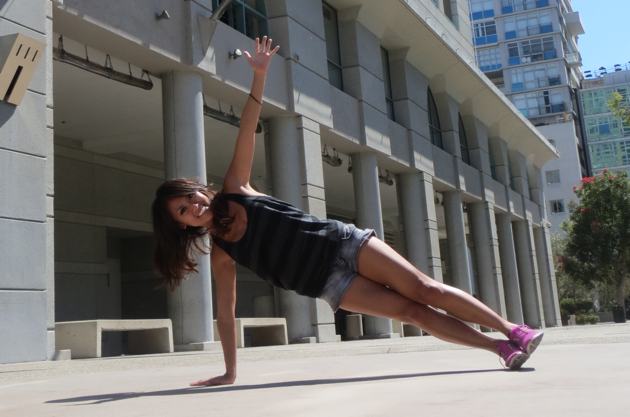I’m not going to lie. Vasisthasana or Side Plank Pose just might be one of my favorite poses, and as a teacher, it kind of saddens me when I see many students clearly NOT enjoying themselves when I call this pose in class.
The wave of nearly imperceptible groans, the looks of dread, the swift move to Child’s Pose, the run to the bathroom—it all happens. And when they are “in” the pose, the discomfort and misery is palpable. Vasisthasana is a nemesis for many people indeed.
This week, I taught Vasisthasana with a foam block between the legs—a technique I learned years ago to help further inform my Tadasana (Mountain Pose), but one that can easily translate to other poses that engage the same actions.
I thought this method would help people find more stability and sustainable strength to be in the pose for several breaths.
It did work successfully up to a point, albeit the usual looks of misery were replaced by bewilderment as the students tried to come to grips with having to balance with a block between their legs, too.
Vasisthasana is not a simple pose. And it does ask you to not only be strong enough to prop yourself up on one arm, but to also balance there for several breaths. There is no slacking in the “paying attention” component of this pose; you need to stay alert for every breath, or you flop over rather indelicately.
Common Misalignments in Side Plank
I’ve highlighted a few common misalignments, areas that offer opportunities for further empowerment. For overall accessibility, I’m focusing on the version of the pose where your legs are stacked, as though someone pushed you over on your side from Tadasana and you kept your alignment intact.
1. Shoulder Meets Ear

In this scenario, a lot more of your body weight and stress is placed on one shoulder, and there is pretty much no way you will feel blissful after one breath—much less five. When you shake here, it’s more likely due to your ligaments and tendons straining, not your muscles working hard.
Refine By Rooting Down To Lift Up. Lift out of the shoulder joint by placing your wrist under the shoulder, and pressing down into the full width of your hand. Slide the bottom tip of your shoulder blade down toward your hip.
These actions will invite you to lift up and cultivate more space between shoulder and ear, as well as more ably support the shoulder joint.
You can also drop the knee closest to the floor directly under your hip to form a 90-degree right angle to the floor; this is a great modification for Vasisthasana that you can explore until the action with the arm and shoulder becomes more familiar to you.
2. Sagging Hips

There is little to no core power or buoyancy to the pose when your hips fall, and your ability to balance is fairly nonexistent.
Refine By Embodying Plank. Similar to the traditional Plank, work to keep shoulders, hips, knees, and heels in one diagonal line. This means firming and toning the core muscles as well as the leg muscles so all the major body parts are engaged.
Stack your hips, and imagine sending your top hip to the sky, without letting it roll out of that stacked alignment. This will all help distribute more of the work away from the supporting wrist and shoulder to some bigger muscle.
3. Listless and Wandering Legs

This is the time when the top leg and foot is doing a hot potato dance around the bottom leg that goes something like: should I be in front?…no, the back…no, I’ll try the front again…wait…and so on. It would be a funny episode if the yogi’s face didn’t look so abject.
Balance is nowhere near and you can bet bliss is farther away with the upper half of the body taking the strain of this wobbly dance.
Refine By Making Two Legs Become One. Firm the legs and flex the feet so a powerful mountain-like quality can be achieved on your side. Instead of letting your legs be dead weights that can literally pull you down, engage the inner leg muscles as though you’re merging two legs to create one bigger leg.
Lengthen your tailbone toward your heels and press your sacrum into your body as you tilt your frontal hip points up towards your head. This will help you line your body up in a more streamlined, manageable way to help reduce the wobbling.
These are all movements you can cultivate in Tadasana and Plank to reinforce the equal standing alignment.
And finally, the Downturned Corners of Lips Syndrome, aka Frown (could also mask as a snarl): This misalignment usually comes along with the rest above, but when you practice these refinements, this one melts away, too.
Let’s hope it will be replaced by its inverse "alignment," something called a ‘smile.’ Try it next time—it’s way fun!


